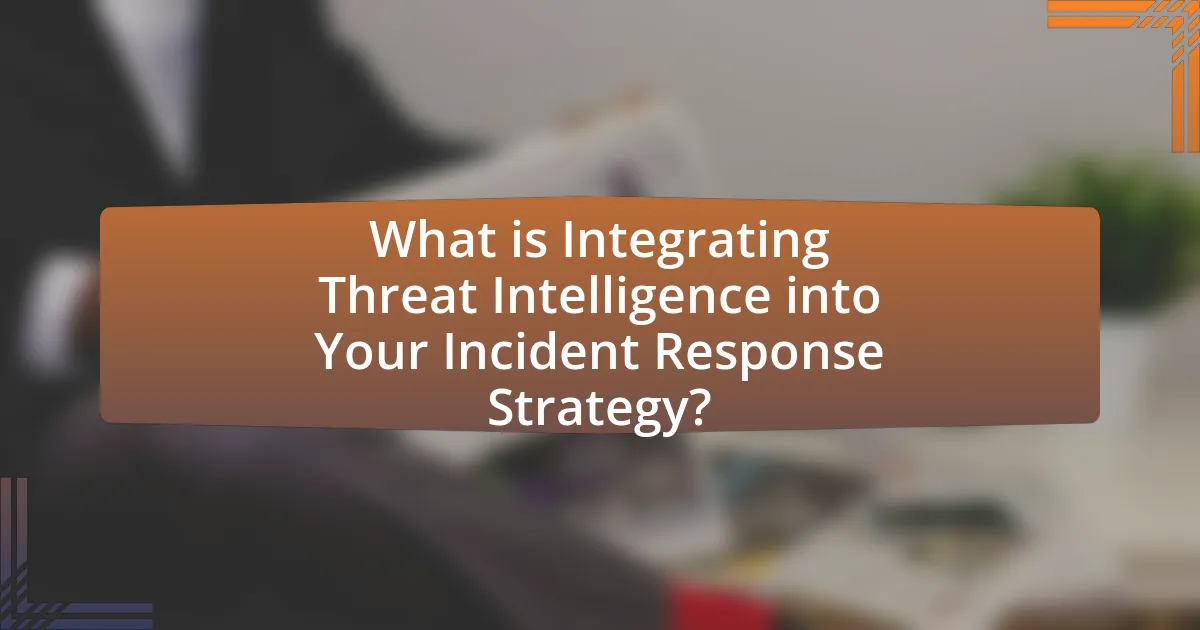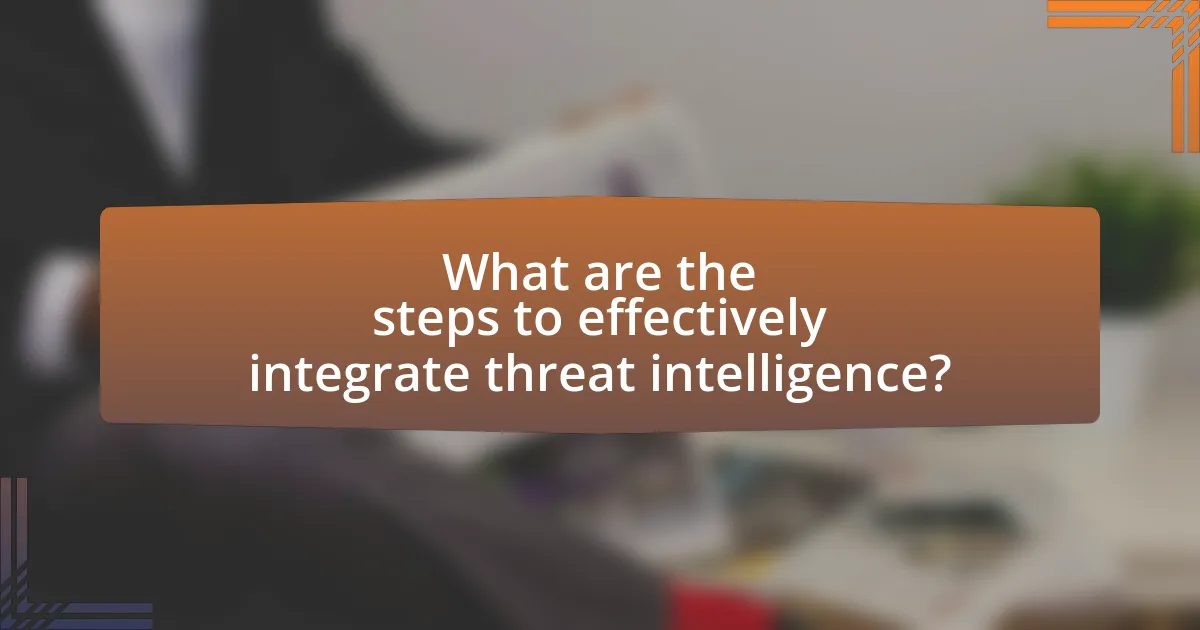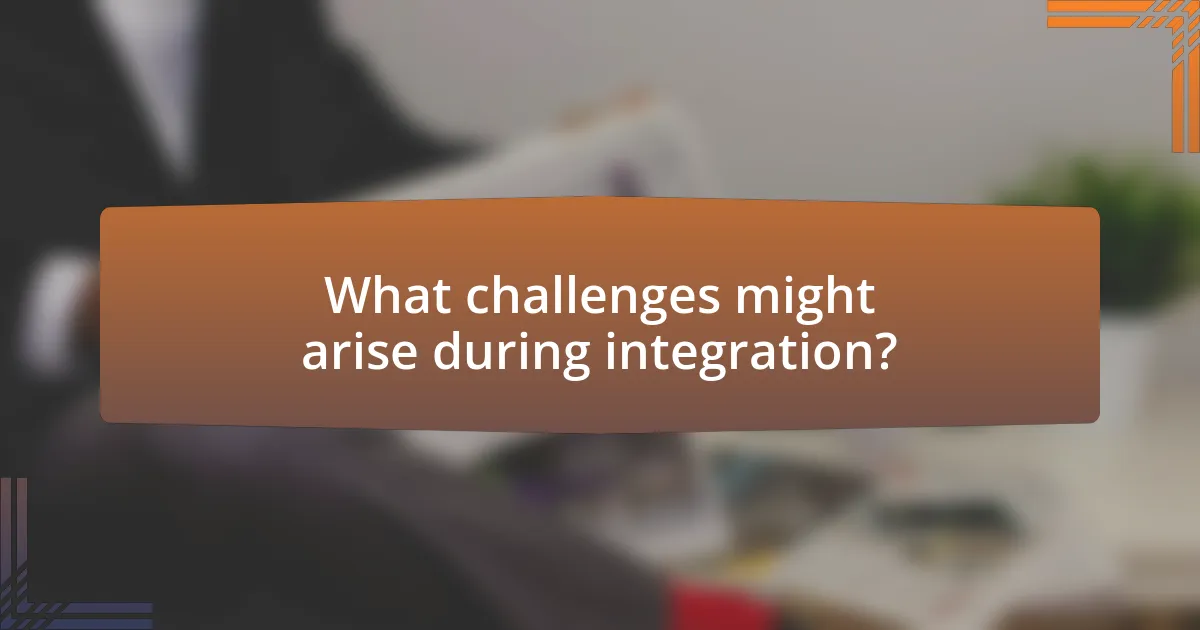Integrating threat intelligence into incident response strategies is essential for organizations aiming to enhance their cybersecurity posture. This article outlines how real-time data and insights about potential threats can improve response effectiveness, reduce breach costs, and minimize incident impacts. Key components of threat intelligence, including data collection, analysis, and dissemination, are discussed, along with the differences between threat intelligence and traditional security measures. The article also addresses the importance of continuous training, collaboration, and the establishment of best practices to maintain an integrated strategy, ultimately emphasizing the need for organizations to proactively adapt to evolving cyber threats.

What is Integrating Threat Intelligence into Your Incident Response Strategy?
Integrating threat intelligence into your incident response strategy involves incorporating real-time data and insights about potential threats to enhance the effectiveness of your response efforts. This integration allows organizations to proactively identify, assess, and mitigate risks by leveraging information about emerging threats, vulnerabilities, and attack patterns. For instance, a study by the Ponemon Institute found that organizations utilizing threat intelligence in their incident response processes can reduce the average cost of a data breach by approximately $1.2 million. This demonstrates that effective integration of threat intelligence not only improves response times but also significantly lowers financial impacts associated with security incidents.
How does threat intelligence enhance incident response?
Threat intelligence enhances incident response by providing actionable insights that inform decision-making during security incidents. By analyzing data on emerging threats, vulnerabilities, and attack patterns, organizations can prioritize their response efforts effectively. For instance, a study by the Ponemon Institute found that organizations utilizing threat intelligence can reduce the average time to detect a breach by 27%, leading to quicker containment and remediation. This proactive approach allows incident response teams to anticipate potential threats and allocate resources more efficiently, ultimately minimizing the impact of security incidents.
What are the key components of threat intelligence?
The key components of threat intelligence include data collection, analysis, dissemination, and actionable insights. Data collection involves gathering information from various sources such as open-source intelligence, dark web monitoring, and internal security logs. Analysis transforms this raw data into meaningful patterns and trends, identifying potential threats. Dissemination ensures that the analyzed intelligence is shared with relevant stakeholders in a timely manner. Finally, actionable insights provide organizations with specific recommendations to mitigate identified threats, enhancing their overall security posture. These components work together to create a comprehensive threat intelligence framework that supports effective incident response strategies.
How does threat intelligence differ from traditional security measures?
Threat intelligence differs from traditional security measures by focusing on proactive identification and analysis of potential threats rather than solely relying on reactive defenses. Traditional security measures typically involve implementing firewalls, antivirus software, and intrusion detection systems that respond to known threats, while threat intelligence emphasizes understanding the tactics, techniques, and procedures used by adversaries to anticipate and mitigate future attacks. This proactive approach is supported by data analytics and threat data sharing, enabling organizations to adapt their security posture based on emerging threats and vulnerabilities, thereby enhancing overall security effectiveness.
Why is integrating threat intelligence crucial for organizations?
Integrating threat intelligence is crucial for organizations because it enhances their ability to anticipate, detect, and respond to cyber threats effectively. By leveraging real-time data on emerging threats, organizations can proactively strengthen their security posture, reducing the likelihood of successful attacks. For instance, a study by the Ponemon Institute found that organizations utilizing threat intelligence can reduce the average cost of a data breach by approximately $1.4 million. This demonstrates that informed decision-making based on threat intelligence not only mitigates risks but also leads to significant financial savings.
What risks do organizations face without threat intelligence?
Organizations without threat intelligence face significant risks, including increased vulnerability to cyberattacks, data breaches, and operational disruptions. The absence of threat intelligence limits an organization’s ability to anticipate and respond to emerging threats, leading to a reactive rather than proactive security posture. For instance, a report by the Ponemon Institute indicates that organizations lacking threat intelligence experience 30% more successful cyberattacks compared to those that utilize it. Additionally, without threat intelligence, organizations may struggle to prioritize security efforts effectively, resulting in inefficient resource allocation and potential financial losses.
How can threat intelligence improve decision-making during incidents?
Threat intelligence enhances decision-making during incidents by providing timely and relevant information about potential threats, enabling organizations to respond effectively. By analyzing data from various sources, threat intelligence identifies patterns and indicators of compromise, which helps incident response teams prioritize their actions based on the severity and likelihood of threats. For instance, a study by the Ponemon Institute found that organizations utilizing threat intelligence can reduce the average time to detect a breach by 27%, leading to quicker and more informed responses. This data-driven approach allows teams to allocate resources efficiently, mitigate risks, and ultimately minimize the impact of security incidents.

What are the steps to effectively integrate threat intelligence?
To effectively integrate threat intelligence, organizations should follow these steps: first, identify and define the specific threat intelligence requirements based on the organization’s risk profile and security objectives. Next, gather relevant threat intelligence from multiple sources, including open-source intelligence, commercial providers, and internal data. After gathering, analyze the collected intelligence to identify patterns, trends, and actionable insights that can inform security measures. Subsequently, integrate the analyzed intelligence into existing security tools and processes, ensuring that it enhances incident detection and response capabilities. Finally, continuously monitor and update the threat intelligence to adapt to evolving threats, ensuring that the integration remains effective over time. This structured approach is supported by industry best practices, such as the MITRE ATT&CK framework, which emphasizes the importance of contextualizing threat intelligence for improved incident response.
How do you assess your current incident response capabilities?
To assess current incident response capabilities, organizations should conduct a comprehensive evaluation of their existing processes, tools, and team readiness. This evaluation typically includes reviewing incident response plans, analyzing past incident reports, and conducting tabletop exercises to simulate real-world scenarios. According to the 2021 Verizon Data Breach Investigations Report, organizations that regularly test their incident response plans are 50% more effective in mitigating breaches. This statistic underscores the importance of continuous assessment and improvement in incident response capabilities.
What metrics should be evaluated in your current strategy?
The metrics that should be evaluated in your current strategy include incident response time, the number of incidents detected, false positive rates, and the effectiveness of threat intelligence sources. Incident response time measures how quickly your team can respond to threats, which is critical for minimizing damage; studies show that organizations with faster response times can reduce the cost of a data breach by an average of $1.2 million. The number of incidents detected reflects the capability of your threat detection systems, while false positive rates indicate the accuracy of those systems. Lastly, evaluating the effectiveness of threat intelligence sources helps ensure that the information being used is relevant and actionable, which can significantly enhance your overall security posture.
How can gaps in your strategy be identified?
Gaps in your strategy can be identified through a comprehensive assessment of current processes, performance metrics, and threat intelligence alignment. Conducting regular audits of incident response protocols reveals inconsistencies and areas lacking in effectiveness. For instance, analyzing response times and outcomes against established benchmarks can highlight deficiencies. Additionally, soliciting feedback from team members involved in incident response can uncover overlooked vulnerabilities. Research indicates that organizations employing threat intelligence frameworks, such as the MITRE ATT&CK framework, can systematically identify weaknesses by mapping their capabilities against known adversary tactics and techniques. This structured approach ensures that all aspects of the strategy are scrutinized, leading to the identification of critical gaps.
What processes should be established for integration?
To effectively integrate threat intelligence into an incident response strategy, organizations should establish processes for data collection, analysis, dissemination, and feedback. Data collection involves gathering threat intelligence from various sources, including open-source intelligence, commercial feeds, and internal logs. Analysis requires evaluating the collected data to identify relevant threats and vulnerabilities, utilizing frameworks like the Cyber Kill Chain or MITRE ATT&CK for context. Dissemination ensures that actionable intelligence is shared with relevant stakeholders, including incident response teams and management, through structured reporting and communication channels. Finally, feedback processes should be implemented to assess the effectiveness of the integration, allowing for continuous improvement based on lessons learned from past incidents and evolving threat landscapes. These processes are essential for creating a proactive and responsive incident management framework.
How can collaboration between teams enhance integration?
Collaboration between teams enhances integration by fostering communication and shared understanding of objectives. When teams work together, they can align their strategies, share critical threat intelligence, and streamline incident response processes. For instance, a study by the Ponemon Institute found that organizations with high levels of collaboration in their security teams experience 50% fewer breaches compared to those with siloed operations. This demonstrates that effective collaboration not only improves the flow of information but also strengthens the overall security posture by enabling a more coordinated and efficient response to threats.
What tools are essential for integrating threat intelligence?
Essential tools for integrating threat intelligence include Security Information and Event Management (SIEM) systems, threat intelligence platforms (TIPs), and endpoint detection and response (EDR) solutions. SIEM systems aggregate and analyze security data from various sources, enabling organizations to detect and respond to threats in real-time. Threat intelligence platforms facilitate the collection, normalization, and dissemination of threat data, allowing security teams to make informed decisions. EDR solutions provide advanced threat detection and response capabilities at the endpoint level, enhancing overall security posture. These tools collectively enhance an organization’s ability to integrate threat intelligence effectively into its incident response strategy.

What challenges might arise during integration?
Challenges that might arise during integration include data compatibility issues, differing organizational cultures, and resource constraints. Data compatibility issues occur when threat intelligence formats do not align with existing systems, making it difficult to utilize the information effectively. Differing organizational cultures can lead to resistance in adopting new processes or technologies, hindering collaboration between teams. Resource constraints, such as limited personnel or budget, can impede the implementation of necessary tools and training for effective integration. These challenges can significantly impact the overall effectiveness of integrating threat intelligence into an incident response strategy.
How can organizations overcome resistance to change?
Organizations can overcome resistance to change by fostering a culture of open communication and involving employees in the change process. Engaging employees through transparent discussions about the reasons for change and soliciting their input can significantly reduce apprehension. Research indicates that organizations that actively involve their workforce in decision-making processes experience a 70% higher success rate in implementing change initiatives. Additionally, providing training and support helps employees adapt to new systems, further mitigating resistance.
What strategies can be employed to foster a culture of security?
To foster a culture of security, organizations should implement comprehensive training programs that educate employees about security best practices and the importance of their role in maintaining security. Regular training sessions, workshops, and simulations can enhance awareness and preparedness, as evidenced by a study from the Ponemon Institute, which found that organizations with ongoing security training programs experience 50% fewer security incidents. Additionally, promoting open communication about security concerns and encouraging reporting of suspicious activities can create a proactive security environment. Establishing clear policies and procedures, along with leadership support, reinforces the significance of security in daily operations, further embedding a security-focused mindset within the organizational culture.
How can training and awareness programs support integration?
Training and awareness programs support integration by equipping personnel with the necessary skills and knowledge to effectively utilize threat intelligence in incident response. These programs enhance understanding of threat landscapes, enabling teams to recognize and respond to potential threats more efficiently. For instance, organizations that implement regular training sessions report a 30% increase in incident response speed, as employees become more adept at identifying and mitigating risks. This improvement is backed by research from the Ponemon Institute, which highlights that organizations with comprehensive training programs experience fewer security breaches and faster recovery times.
What technical challenges should be anticipated?
Integrating threat intelligence into an incident response strategy presents several technical challenges, including data integration, real-time analysis, and information overload. Data integration involves the difficulty of consolidating threat intelligence from diverse sources, which may use different formats and standards, complicating the aggregation process. Real-time analysis is challenging due to the need for rapid processing of large volumes of data to identify threats promptly, requiring advanced analytics and machine learning capabilities. Information overload occurs when security teams are inundated with excessive alerts and data, making it difficult to prioritize and respond effectively. These challenges are supported by industry reports indicating that 70% of organizations struggle with data integration and 60% report difficulties in real-time threat detection.
How can data overload be managed effectively?
Data overload can be managed effectively by implementing data prioritization and filtering techniques. Organizations can utilize automated tools that analyze incoming data streams, categorizing and prioritizing information based on relevance and urgency. For instance, threat intelligence platforms can aggregate data from various sources and apply machine learning algorithms to identify critical threats, reducing noise and focusing on actionable insights. Research indicates that companies employing such systems experience a 30% reduction in response time to incidents, demonstrating the effectiveness of these strategies in enhancing incident response capabilities.
What are the best practices for ensuring data accuracy and relevance?
The best practices for ensuring data accuracy and relevance include implementing regular data validation processes, utilizing automated tools for data collection, and establishing clear data governance policies. Regular data validation processes, such as cross-referencing data with reliable sources, help identify and correct inaccuracies. Automated tools, like data scraping and real-time analytics, enhance the efficiency of data collection, ensuring that the information is current and relevant. Clear data governance policies define roles and responsibilities for data management, which fosters accountability and consistency in data handling. These practices collectively contribute to maintaining high standards of data integrity, essential for effective incident response strategies in threat intelligence.
How can organizations measure the success of their integration?
Organizations can measure the success of their integration by evaluating key performance indicators (KPIs) such as incident response time, the accuracy of threat detection, and the reduction in false positives. For instance, a study by the Ponemon Institute found that organizations with integrated threat intelligence reduced their incident response time by an average of 30%. Additionally, tracking the number of incidents successfully mitigated due to timely intelligence can provide concrete evidence of integration effectiveness. Regular assessments through post-incident reviews and feedback loops also contribute to understanding the integration’s impact on overall security posture.
What key performance indicators should be tracked?
Key performance indicators (KPIs) that should be tracked in integrating threat intelligence into your incident response strategy include mean time to detect (MTTD), mean time to respond (MTTR), number of incidents detected, and false positive rate. MTTD measures the average time taken to identify a security incident, while MTTR assesses the average time required to respond to and mitigate incidents. Tracking the number of incidents detected provides insight into the effectiveness of threat intelligence, and monitoring the false positive rate helps evaluate the accuracy of detection mechanisms. These KPIs are critical for assessing the efficiency and effectiveness of an incident response strategy, enabling organizations to improve their security posture over time.
How can feedback loops improve the integration process?
Feedback loops can enhance the integration process by facilitating continuous improvement and adaptation in response strategies. These loops allow organizations to gather insights from past incidents, analyze the effectiveness of their responses, and adjust their threat intelligence accordingly. For instance, a study by the Ponemon Institute found that organizations utilizing feedback mechanisms in their incident response saw a 30% reduction in response times, demonstrating that iterative learning from previous experiences leads to more effective integration of threat intelligence.
What are the best practices for maintaining an integrated strategy?
The best practices for maintaining an integrated strategy include establishing clear communication channels, aligning objectives across teams, and continuously updating threat intelligence. Clear communication ensures that all stakeholders are informed and can collaborate effectively, which is crucial for timely incident response. Aligning objectives across teams fosters a unified approach to threat management, enhancing overall effectiveness. Continuous updates to threat intelligence allow organizations to adapt to evolving threats, ensuring that the strategy remains relevant and effective. These practices are supported by studies indicating that organizations with integrated strategies experience faster response times and reduced incident impact.
How often should threat intelligence be updated and reviewed?
Threat intelligence should be updated and reviewed continuously, ideally on a daily basis. This frequency is essential due to the rapidly evolving nature of cyber threats, where new vulnerabilities and attack vectors emerge regularly. According to the 2021 Verizon Data Breach Investigations Report, 85% of breaches involved a human element, highlighting the need for timely updates to threat intelligence to address emerging risks effectively. Regular updates ensure that organizations can adapt their incident response strategies to the latest threat landscape, thereby enhancing their overall security posture.
What role does continuous training play in sustaining integration?
Continuous training is essential for sustaining integration in incident response strategies by ensuring that team members remain updated on the latest threat intelligence and response techniques. This ongoing education fosters adaptability and enhances the team’s ability to respond effectively to evolving threats. Research indicates that organizations with regular training programs experience a 50% reduction in incident response times, demonstrating the direct impact of continuous training on operational efficiency and integration.
